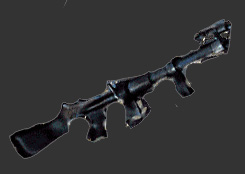Blaster Theory
Blasters
Slugthrowers
Grenades
Melee Weapons
Other Weapons
Course Exam
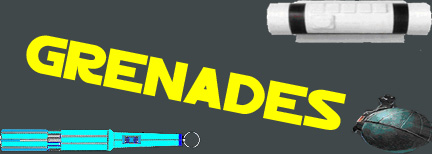
Grenades are individual explosive devices, either hand-thrown or propelled from a launcher. Primarily a short range anti-personnel weapon, they either explode upon impact or a short time after release.
Archeological evidence shows the use of grenades goes back tens of thousands of years, predating the Republic and spaceflight itself. Historians have also shown grenades were in common use even before the rise of slugthrowers in ancient times, deployed alongside primitive swords, bows, and spears.
Grenades are available in a wide variety of models with many different applications. Unless otherwise stated, grenades use detonite as the primary explosve charge.
The fragmentation grenade is little-changed from its ancient ancestors. Consisting of an explosive core encased in metal, upon detonation it hurls thousands of tiny metal fragments, known as shrapnel, in all directions with an effective radius of 4 meters. Frag grenades are the cheapest type to produce and are found in great quantities among the various militaries and mercenary groups of the galaxy. Detonation occurs via impact or timer if the magnetic grapple is used to attach the frag grenade to a metallic surface.
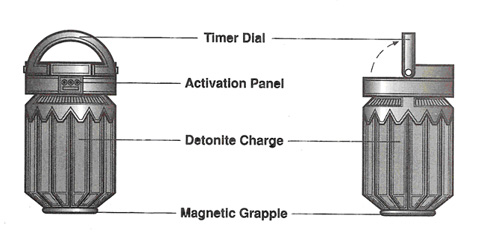
Concussion grenades are almost as old as the fragmentation variety and have seen widespread use since well before the Republic was formed. Releasing a kinetic energy blast, the concussion grenade is lethal to organic beings within 4 meters. Since the concussive wave does little damage to equipment or structures, these grenades are commonly used aboard ships or in enclosed spaces where piercing the walls or hull is undesirable.
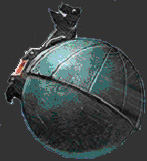
When it is desirable to take enemies alive or when hostages are present, stun grenades are the weapon of choice. Weighing approximately 0.5 kg and with a blast radius of 4 meters, they are designed to incapacitate individuals with concussive force. Stun contain impact detonators and are usually thrown through an open door or window prior to forced entry by friendly forces. This tactic greatly reduces the risk of casualties.

Smoke grenades obscure areas and provide visual cover by releasing clouds of thick smoke. Multiple colors are available, indicated by the color of the grenade's cap. Smoke grenades can mark landing zones for friendly transports or mark enemy targets for strafing runs by air support forces. Also useful for crowd control in urban environments. The smoke produced does not impair the vision of personnel wearing MFTAS-equipped helmets such as those worn by Imperial Stormtroopers. Remember that the enemy is unlikely to hit what they cannot see.

Rather than using traditional explosives, the glop grenade utilizes high-pressure air to expel a large volume of thick foam. Once ejected in a 10 meter radius by the internal jets, the foam solidifies into an extremely strong adhesive within a few seconds of coming into contact with air, effectively trapping any beings caught within the effected area. This reusable grenade detonates upon impact or after a 15 second timer elapses Glop becomes brittle after 5 minutes, allowing trapped individuals to be freed. It dissolves more quickly under a special aerosol solvent created by the Corporate Sector Authority.

Cryoban grenades were originally intended as emergency fire suppressants. Utilizing carbon freezing technology, the cryoban disperses carbonite gas in a 10 meter radius, immobilizing everyone and everything in range for several minutes. The extreme cold causes intense pain and can be lethal to organic beings. Equipment and droids become brittle and are easily destroyed when similarly exposed.

Electromagnetic Pulse or EMP Grenades, is primarily an anti-droid weapon. Detonating upon impact or after a 5 second timer, the EMP releases an omnidirectional burst of disruptive electrical energy, which damages and disables electronic circuits within the 20 meter blast radius. The effects of the blast diminish as distance from point of impact increases, with minimum disruption lasting a few seconds along the outer edge of the blast zone. Droids or other systems at or near the EMP detonation will be destroyed or severely disrupted for up to one hour.
The EMP is less effective against organics, but may still electrocute lifeforms, stunning them for a brief time. Electronic equipment is affected similarly to droids, specifically communications and Stormtrooper helmets are disrupted for several seconds. Do not throw EMP grenades indiscriminately when the possibility of adversely affecting friendly troops exists.

The Merr-Sonn 7-PrG Proton Grenade is a very powerful explosive charge used for structural demolition and disabling large vehicles such as the AT-AT. The Proton Grenade operates on the same principle as the proton torpedoes carried by starfighters and capital ships. The proton-detonated baradium main charge releases a titanic explosion, but only in the direction of the magnetic base plate. Due to the immense destructive power, the 7-PrG is armed by two separate mechanisms: a twist timer capable of up to 20 minute delays, and an activation plunger. The two-stage device ensures no unintended detonations occur.
The Proton Grenade differs from the other grenades in this course in that it is neither thrown or launched. To operate:
- Place the proton grenade on a flat metallic surface with the bottom magnetic adhesion plate resting against the desired target.
- Twist the timer to the desired delay time.
- Lift, then depress the activation plunger.
- Evacuate to minimum safe distance immediately.
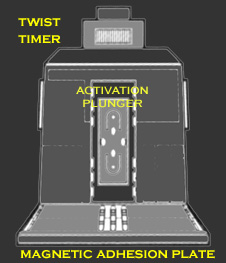
Thermal detonators are highly-unstable baradium-charged grenades popular with militaries throughout the galaxy. Designed to be thrown or planted by an individual soldier, the thermal detonator will cling to metallic surfaces until detonation. Thermal detonators explode after a 6-18 second delay set by the user, or can be set to explode instantaneously if the activation switch is released prior to setting the time delay. Upon explosion, the thermal detonator releases an expanding particle field that atomizes all matter within a 5 meter radius. The field quickly collapses, leaving everything outside its blast radius completely unharmed. To the right are examples of the two most common thermal detonators: the spherical model and the cylindrical version issued to Stormtrooper units. Both are equally lethal and very unstable. Exercise extreme caution when handling thermal detonators.


The CSPL-12 or Caspel Grenade Launcher is an invaluable tool for any Stormtrooper unit. Capable of launching grenades up to 250 meters, it carried a variety of payloads including all standard grenade types, plus canisters of Plank Gas (a corrosive anti-materiel gas), Spore B (Bothan Stun Spores), and FEX-M3 Nerve Toxin.
